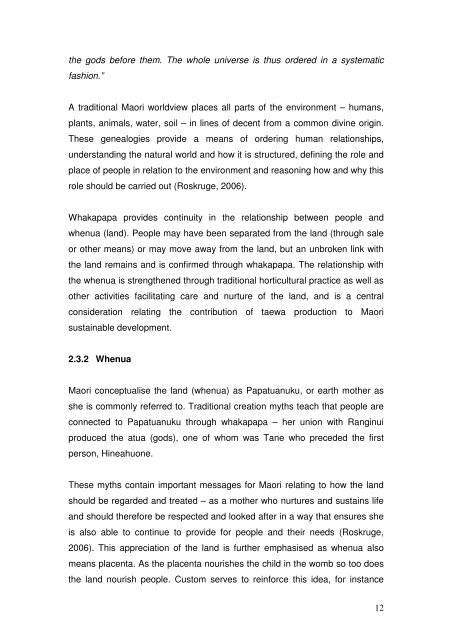Lincoln University Digital Dissertation - Lincoln University Research ...
Lincoln University Digital Dissertation - Lincoln University Research ...
Lincoln University Digital Dissertation - Lincoln University Research ...
You also want an ePaper? Increase the reach of your titles
YUMPU automatically turns print PDFs into web optimized ePapers that Google loves.
the gods before them. The whole universe is thus ordered in a systematic<br />
fashion.”<br />
A traditional Maori worldview places all parts of the environment – humans,<br />
plants, animals, water, soil – in lines of decent from a common divine origin.<br />
These genealogies provide a means of ordering human relationships,<br />
understanding the natural world and how it is structured, defining the role and<br />
place of people in relation to the environment and reasoning how and why this<br />
role should be carried out (Roskruge, 2006).<br />
Whakapapa provides continuity in the relationship between people and<br />
whenua (land). People may have been separated from the land (through sale<br />
or other means) or may move away from the land, but an unbroken link with<br />
the land remains and is confirmed through whakapapa. The relationship with<br />
the whenua is strengthened through traditional horticultural practice as well as<br />
other activities facilitating care and nurture of the land, and is a central<br />
consideration relating the contribution of taewa production to Maori<br />
sustainable development.<br />
2.3.2 Whenua<br />
Maori conceptualise the land (whenua) as Papatuanuku, or earth mother as<br />
she is commonly referred to. Traditional creation myths teach that people are<br />
connected to Papatuanuku through whakapapa – her union with Ranginui<br />
produced the atua (gods), one of whom was Tane who preceded the first<br />
person, Hineahuone.<br />
These myths contain important messages for Maori relating to how the land<br />
should be regarded and treated – as a mother who nurtures and sustains life<br />
and should therefore be respected and looked after in a way that ensures she<br />
is also able to continue to provide for people and their needs (Roskruge,<br />
2006). This appreciation of the land is further emphasised as whenua also<br />
means placenta. As the placenta nourishes the child in the womb so too does<br />
the land nourish people. Custom serves to reinforce this idea, for instance<br />
12
















